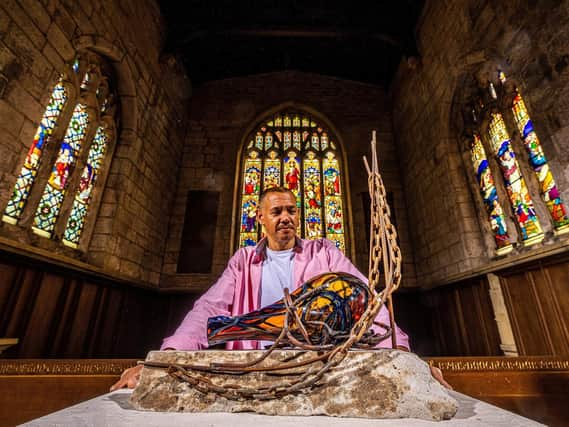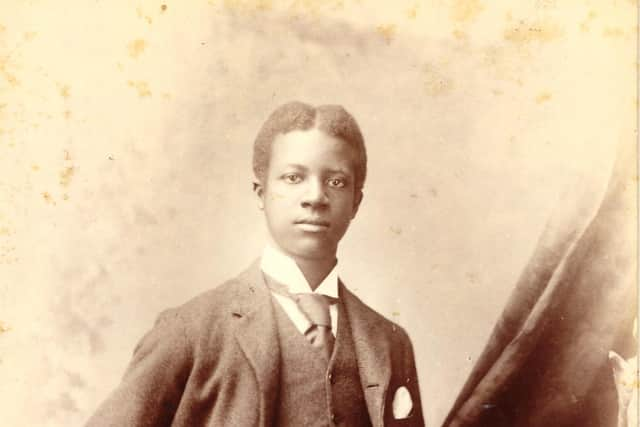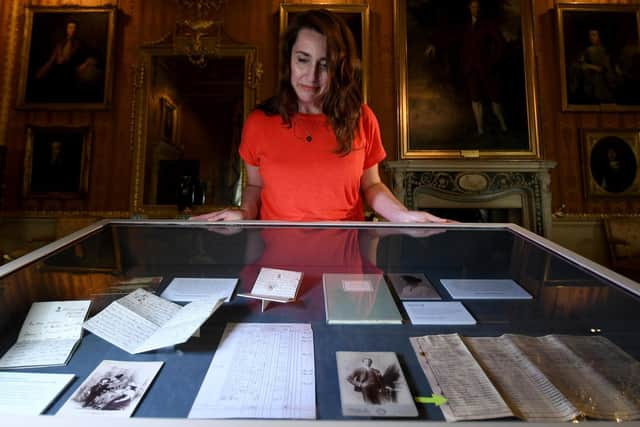Glass artist Chris Day and the story of George 'Bertie' Robinson feature at Harewood House in its focus on black history


David Lascelles, Earl of Harewood, spoke of what he, the Countess of Harewood and Harewood House Trust have done to address the estate’s heritage.
“I think it’s a period of history that as a nation, we’ve not come to terms with properly,” he said. “I think that, until we do, a lot of the divisions, a lot of the conflicts, can’t be resolved until we understand our history.”
Advertisement
Hide AdAdvertisement
Hide AdMuch of Britain’s wealth in the 18th-century came from the sugar plantations and the Lascelles family built up vast fortunes from sugar, cotton, tobacco and rum – all on the back of the slave trade.


Harewood House was built from these proceeds – and it’s not something the Trust and the modern day Lascelles family have shied away from discussing. They have been at the forefront of acknowledging the estate’s colonial past for more than 25 years, and have commissioned artists of diverse heritage and spoken about the family’s links to the Slave Trade.
This resulted in a year-long programme of events to mark the bicentenary of the Abolition of Slavery in 2007, featuring Geraldine Connor’s Carnival Messiah, an epic reimagining of Handel’s Messiah.
The murder last year of George Floyd and its profound impact on the Black Lives Matter movement was the trigger for a renewed focus on promoting diversity and inclusion and combating racism.
Advertisement
Hide AdAdvertisement
Hide AdIt has led to the launch of a series of projects including the introduction of A Storm at Harewood – a walking story run by Joe Williams and Vanessa Mudd of Heritage Corner, in which they explore black history and hidden connections to Harewood through the guise of Pablo Fanque and his wife. Fanque was Britain’s first recorded circus owner of African heritage and brought his circus to the Harewood area in 1847.


Earlier this summer an exhibition by glassblower Chris Day opened in Harewood’s All Saints’ Church as part of a new, biannual, Craft Spotlight series to provide a platform for emerging makers and designers from diverse ethnic backgrounds.
Day is a glass and ceramic artist who creates glass artworks influenced by back history and the Transatlantic Slave Trade, so when he was contacted by Hannah Obee, director of collections, programming and learning for the Harewood House Trust, about exhibiting in the chapel, he was keen to be involved.
“As a black glassblower, I am one of few and on a quest to find and inspire more. My main purpose, however, is to engage the audience on issues that are hard to confront on many levels, using art to help overcome some of the traumas that haunt our collective past,” he says.
Advertisement
Hide AdAdvertisement
Hide AdDay comes from a mixed race background, Jamaican and Anglo-Irish, and has spent time researching the history of the slave trade in the 18th Century and the civil rights movement. He says some people perhaps don’t realise just how ingrained slavery was in this country at one time. “The churches were involved, the banks were involved, everyone was involved. Even people who had a butcher’s shop or a carpentry business could buy into slavery, they could have a part-owned share of a slave.”
The slaves themselves were seen as nothing more than a commodity. “They were like a slice of beef or things we transport today, like clothes or mobile phones. They weren’t seen as human.”
Day combines the iridescent beauty of his glass work with the treatment of black people and our colonial heritage. “I’ve always said my work’s like a spider’s web. I try to entrap people with the beauty of the glass and then there’s this deeper conversation to be had if they want to.”
He believes there is a greater awareness of racism and the issues surrounding it than ever before. “Black Lives Matter and poor old George Floyd have propelled everything. Five years ago, would people have been interested in the stories of Emmett Till (a 14-year-old African American who was lynched in Mississippi in 1955) and George Stinney (who was executed in the US at the age of 14 in 1944)?” he says. When I started doing work about slavery I thought ‘how can I talk about it? But then I thought ‘if I don’t do it, then who is?’”
Advertisement
Hide AdAdvertisement
Hide AdPart of the appeal of exhibiting at Harewood was his desire to reach a wider audience. “I want to reach the school kids, the grandmas and the granddads, people who might not often go to an art exhibition,” he says. “What Harewood is doing is what needs to be done. It’s about having that conversation for the masses.”
As well as displaying Day’s poignant glass sculptures, Harewood is also running an exhibition in the main house which pieces together the story of George ‘Bertie’ Robinson – the first black member of staff known to have worked at the estate.
He travelled with the 5th Earl and Countess from St Vincent to Leeds aged just 13 to work for the Lascelles family, and the exhibition – Bertie Robinson: The Footman from St Vincent – is part of an annual series that will share the histories of people of African descent with Yorkshire connections.
Bertie lived at Harewood from 1893 to 1922, and although nothing survives in his own voice, with the help of Leeds-based DSRG (the Diasporian Stories Research Group) and references to him in letters, documents and diaries, they have been able to piece together his poignant story.
Advertisement
Hide AdAdvertisement
Hide Ad“These are the people that history has brushed to one side, but if you only ever tell the stories of people whose voices and possessions survived you only tell one part of the history, and he is as much a part of the history of Harewood as anyone else,” says Hannah Obee.
After being employed at Harewood for nearly 30 years, during which time he worked his way up to becoming a footman, Bertie’s career there ended abruptly in 1922 when he stole a £50 note (the equivalent of around £3,000) from the 5th earl.
The story behind the theft is a heart-wrenching one. “We know from correspondence from the family that this was totally out of character but it turns out that a year before he’d had an illegitimate child with a local woman [Elizabeth] and he was trying to support the child,” says Obee.
He was told to leave the country and it’s known that he travelled to Trinidad but after that there’s no trace of what happened to him.
Advertisement
Hide AdAdvertisement
Hide AdUntil recently it wasn’t known what happened to his child, either. “One of the research group’s members was contacted by a woman who’d been to Harewood years ago and was looking downstairs and spotted an image of Bertie and it turns out that her father was Bertie’s son.”
They found out that his son, Bertie Robinson Wray, was given away for adoption when he was just 12 months old.
“When you start unpicking his (Bertie’s) story you understand how racism works,” says Obee. “There are so many different layers and it affects so many lives.
“If he hadn’t been black there probably would have been a very different outcome to this story. Instead, he doesn’t get to know his son, and his son doesn’t get to know either of his parents and you have a family today trying to uncover their history.”
Advertisement
Hide AdAdvertisement
Hide AdObee believes it’s important these stories and the issues they raise are told. “It’s about starting a debate and looking at how we use Harewood’s collections to do that.”
For more information about events at Harewood House go to https://harewood.org/ or call 0113 218 1010
Comment Guidelines
National World encourages reader discussion on our stories. User feedback, insights and back-and-forth exchanges add a rich layer of context to reporting. Please review our Community Guidelines before commenting.